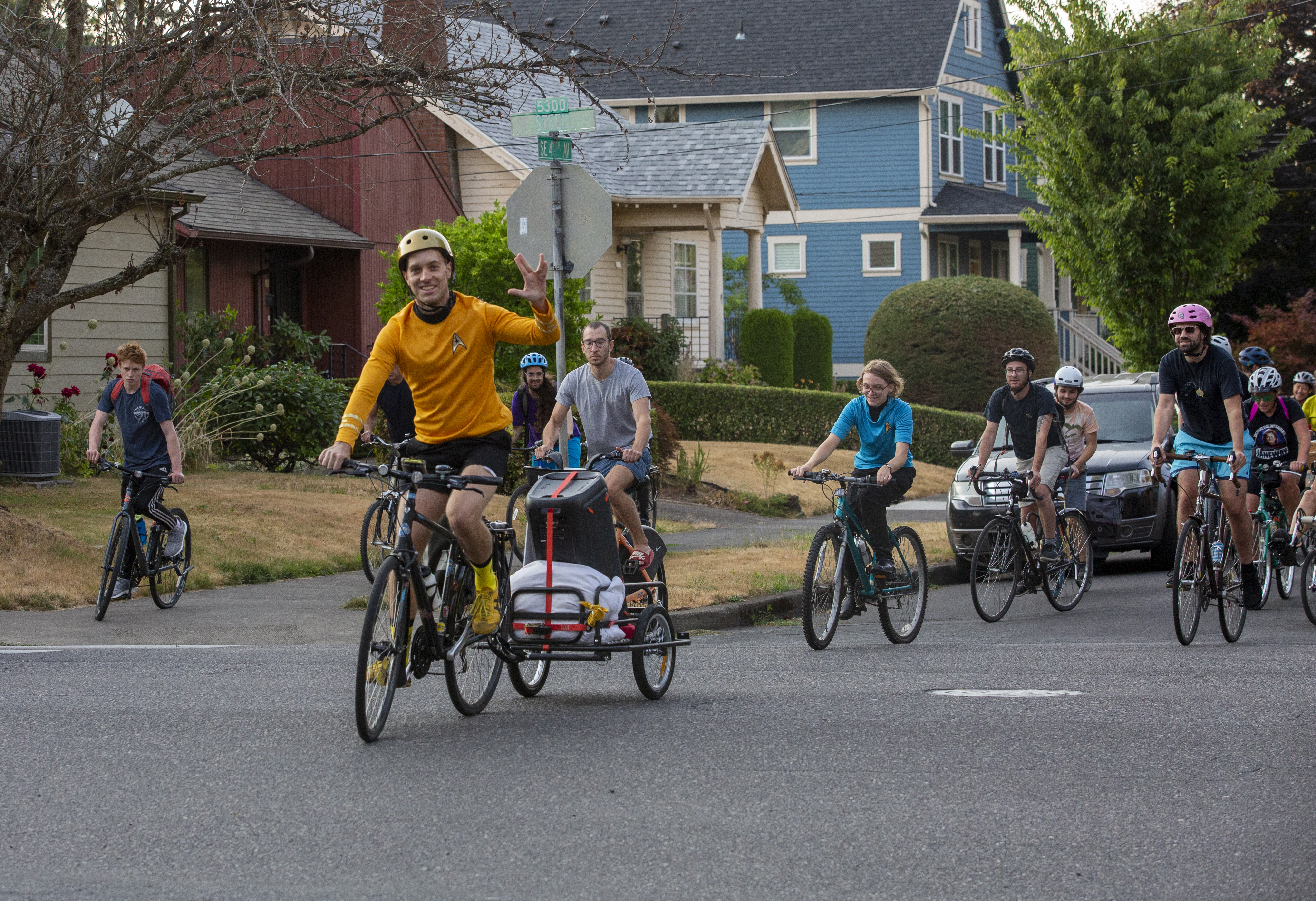
The bikers of Portland's Pedalpalooza Star Trek ride arrive at Woodstock Park in Southeast Portland led by Joe Gavrilovich, dressed as Captain Kirk and holding up the Vulcan hand sign for "Live long and prosper," on Thursday, August 5, 2021.
Hanin Najjar / OPB
Oregon’s growth management agency is moving ahead with new rules to spur denser housing development, more robust bicycle networks and less automobile parking in new developments.
The sweeping new development rules are designed to produce more compact communities where people are less dependent on cars and trucks in their daily lives and to provide more housing for people who have been marginalized.
“We’re not trying to outlaw cars, but our investments really focus on automobile use,” said Robin McArthur, the outgoing chair of the Oregon Land Development and Conservation Commission. “If we can balance that out and expand the transportation network to give people chances to walk and bike and use transit, in addition to their single-occupancy vehicle, that’s a really good choice that people can make.”
After a lengthy hearing Thursday, the commission decided to put off finalizing its rules until July. But it did adopt temporary rules so it can start doling out planning money to local governments in Oregon’s eight metropolitan regions. The rules came under fire from several business groups, as well as city and county officials from around the state who protested they needed more time and money to work on revamping their zoning plans.
Oregon has long had a unique system of urban growth boundaries that protect farms, forests and other open spaces from sprawling urban development. That by itself has led to more compact cities than what is found in most states. And three years ago, Oregon became the first state to abolish exclusive single-family zoning, allowing up to four units on those lots.
The new Climate-Friendly and Equitable Communities package of rules would take more steps down this path.
The eight metro areas would be required to designate “climate-friendly areas” covering at least 30% of their new housing development. Homes in this area would be multi-family or small single-family homes on small lots. They would have good transit, bicycling and walking connections, and be close to commercial and other services.
Cities would be required to plan for “robust” networks that people can safely travel on by bicycle or other small conveyances for trips of up to three miles.
In addition, local governments would be required to pare back many of their ordinances requiring business and housing developments to have a certain number of parking spaces. Critics of America’s heavy dependence on autos have charged for years that minimum parking mandates lead to excessively large lots that take up too much valuable urban space.
Cities could have a variety of options in how they want to pare back parking rules. They could leave it up to developers or property owners to decide. They also could look at putting charges on curbside parking or letting people give up free parking at work in exchange for extra cash.
Reducing greenhouse gases
The new rules were developed partly in response to Gov. Kate Brown’s 2020 executive order calling on more than a dozen state agencies to do what they could to reduce the state’s greenhouse-gas emissions. The growth management agency also decided that it should work closely with affordable housing providers and racially diverse groups in putting together the new rules.
“We’re really trying to promote more equitable communities,” said McArthur, adding that having a wider range of housing in communities will lead to more diversity in them.
The new rules come as the state is struggling with a deep housing shortage. A state report last year estimated that Oregon is more than 110,000 homes short of meeting demand.
Several business groups said additional regulations could make it harder to dig out of that housing shortage.
Jon Kloor, chairman of the Albany Area Chamber of Commerce, said his community has been looking at every possible tool to increase the housing supply.
However, he added, “The Albany chamber is confident that adding new expensive and onerous rules and regulations on land development and construction will only exacerbate the issue.”
Officials from the Oregon Farm Bureau and a manufacturers association said they worried the rules could shift resources from road construction and make it more difficult to get their products to market.
Mary Kyle McCurdy, deputy director of 1000 Friends of Oregon, countered that building more housing on the outside fringe of metropolitan areas is not the right direction to go.
“We need more housing inside our urban growth boundaries where people already go to school or work,” add McCurdy, whose group has long supported strong growth management controls. “Business as usual with more subdivisions at the edge or through expanded urban growth boundaries is not good for the climate, and it’s not delivering affordable housing.”
On Friday, the commission also unanimously voted to elevate Anyeley Hallová to the commission’s chairmanship. The Portland developer has been the first Black member to serve on the commission in its nearly 50-year history.